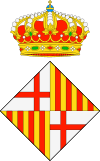Via Laietana, Barcelona
| Via Laietana | |||
| Barcelona Street | |||
| Looking South towards the Port | |||
|
|||
| Country | Spain | ||
|---|---|---|---|
| State | Catalonia | ||
| District | Ciutat Vella | ||
| City | Barcelona | ||
| Length | 1.1054 km (1 mi) | ||
| Date | Constructed in 1907 | ||
 Via Laietana within the district of Ciutat Vella
| |||
Via Laietana (Catalan pronunciation: [ˈbi.ə ɫəjəˈtanə]) is the name of a major thoroughfare in Barcelona, Catalonia, Spain in the Ciutat Vella district.
Overview
This avenue runs from Plaça Urquinaona to Plaça d'Antonio López, by the seafront, and separates the neighbourhoods of the old city it has on each side: La Ribera/El Born and Sant Pere on one, and Barri Gòtic opposite. Besides being always overcrowded with both locals and tourists attracted by its Modernista Art Nouveau, Art Déco and Noucentista neo-classical architecture, in addition to its nearness to the Ramblas and the quiet pedestrian streets of Barri Gòtic, Via Laietana hosts the headquarters of a number of banks (notably Caixa Catalunya) and institutions.
It can be seen as an extension of Carrer de Pau Claris in Eixample. Via Laietana was named after the Laietanii, an Iberian people who inhabited the region around Barcelona, Maresme, Vallès and Baix Llobregat.
History
The construction of Via Laietana was first projected in 1879 and started in 1907, with the aim of communicating Eixample with the waterfront, amid much controversy. The demolition of a large number of houses and the removal of the streets in the area was required to do so. As some of the traditional guilds of the city, some dating back to the Middle Ages, were located there, they had to be relocated in different parts of Barri Gòtic, notably Plaça de Sant Felip Neri. The first section to be built was named Carrer de Bilbao, which nowadays is a separate, shorter street that stems from the larger Via Laietana. The avenue was finished in 1926. Francesc Cambó, a prominent politician of the time, built his personal residence in the avenue. During the years of the Spanish Civil War (1936-1939) it was renamed Via Durruti.
Architecture
As an avenue built in the early 20th century, its buildings reflect the aesthetic ideals of the period, and of the different political regimes. The style of some of its buildings has no other referent in Barcelona and has much more in common with the architecture that can be seen in Madrid. A number of these buildings are being converted into hotels.
Buildings of interest
- Conservatori Superior de Música del Liceu
- Caixa de Pensions Building (1917), by Enric Sagnier - Unusual office building built in a trend of the Neo-Gothic style inspired by central European churches with a white façade.
- Casa Bulbena-Salas (1924-1926) by Joan A. Roig.
- Edifici del Col·legi d'Enginyers Industrials (1922) by Antoni Ferrater.
- Casa Artur Suqué (1927) by Adolf Florensa.
- Caixa Catalunya building (1931) by José Yárnoz Larrosa and Luis Menéndez Pidal Álvarez - It's been the Caixa Catalunya headquarters since 1955, but originally hosted Banco de España.
- Casa dels Velers (1758-1763) by Juan Garrido i Bertrán
- Foment del Treball building (1934-1936) by Adolf Florensa - rationalist building, influenced by the Chicago School.
- Edifici de Tabacs (1923) by Francesc Guàrdia Vidal.
- Edifici de Correus (1926-1927 by Josep Goday Casals and Jaume Torres Grau.
Places of interest in the vicinity
- Palau de la Música Catalana
- Santa Caterina market
- Cathedral of Santa Eulàlia
Two closed metro stations
Via Laietana hosted two metro stations that were finally dismantled and abandoned because of different reasons. Correos was closed because of major changes in the metro line that crossed the area, and Banco was never opened.
Transport
Bus
- Line 17
- Line 19
- Line 40
- Line 45
Metro
- Jaume I (L4)
- Urquinaona (L1, L4)
Gallery
-

Casa Heribert Sales, with Casa Bulbena-Salas in the background.
-

Caixa de Pensions building.
-
The prestigious Palau de la Música Catalana is located next to Via Laietana
-
View North along the Via Laietana.
See also
- History of Barcelona
- Carrer de Pau Claris
- Adolf Florensa
- Francesc Cambó, Avinguda de Francesc Cambó
- List of streets and squares in Eixample
References
- ALBAREDA, Joaquim, GUÀRDIA, Manel i altres.Enciclopèdia de Barcelona, Gran Enciclopèdia Catalana, Barcelona, 2006.
External links
Coordinates: 41°23′07″N 2°10′37″E / 41.38528°N 2.17694°E

